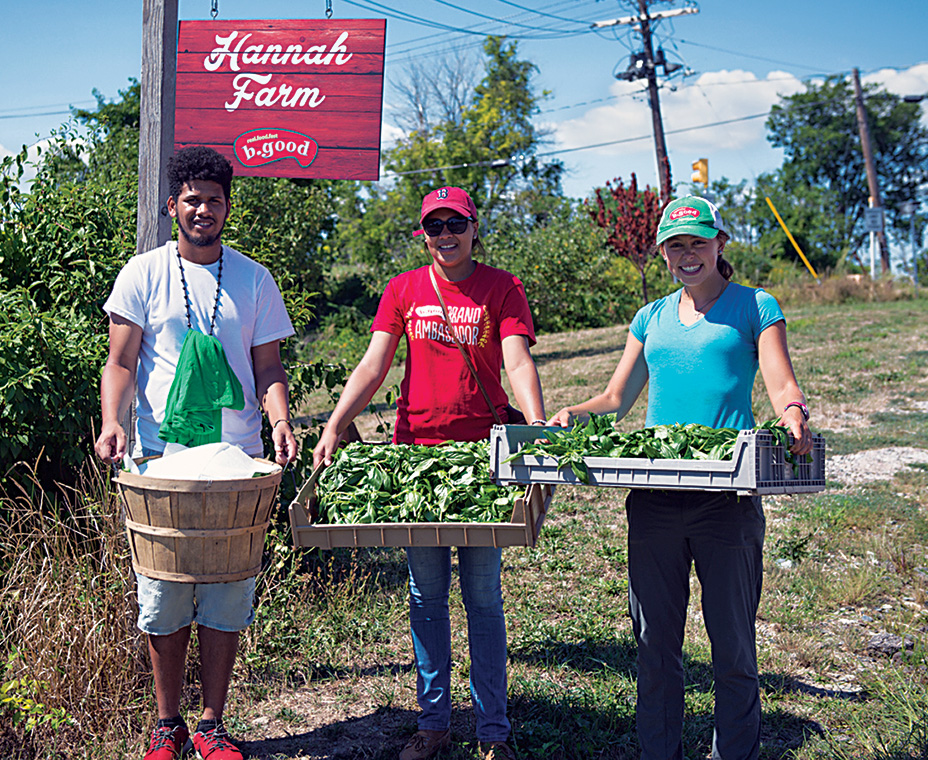Jon Olinto, cofounder of healthy fast casual b.good, found himself a fertile piece of land.
Earlier this year, Olinto launched Hannah Farm, a one-acre plot on an island off Boston’s coastline, for which b.good signed a two-year lease. Seventy-five percent of the produce from Hannah Farm goes to feed kids at Camp Harbor View, a program for at-risk urban youth, and the rest is funneled back into b. good units.
As consumers continue to clamor for wholesome food and restaurant transparency, more operators like Olinto are considering how vertical integration can redefine the farm-to-fork formula. Not only does it offer greater control over their supply chain, but it also lends restaurant owners the opportunity to better connect with the communities they serve.
Olinto says there are also business benefits to a brand having its own farm. “It can drive a lot of customer engagement,” Olinto says. “Volunteer sign-up was sold out in less than 48 hours. People were fired up to come work with us for a day. We had two customers every weekday for two months. That’s huge.”
Engaging the community and making them a part of the experience goes a long way toward building a bond with the brand, Olinto adds. “And it can become a way for your staff to have a real connection to local agriculture and to the mission of the company.”
Company mission is what brought New York City–based Dig Inn to the farm business as well.
Founder and CEO Adam Eskin is close to signing a contract on 40 acres in Clinton Corners, New York, just two hours north of the city. The short-term plan is to grow produce for Dig Inn’s 12 restaurants. The long-term plan is much more ambitious: a working farm with a restaurant, as well as overnight accommodations for travelers who want to pet the goats and chickens, meet the farmers, and pick tomatoes.
Eskin acknowledges his vision of a destination farm and restaurant is a long way off. The goal now is to have a working greenhouse on the property by February 2017.
B.good had already been helping the Camp Harbor View with its lunches, so when the land adjacent to the camp became available, camp administrators contacted Olinto, thinking it tied in with the restaurant’s mission of giving back.
“I never thought about the opportunity as just a way for us to grow produce for our restaurant,” Olinto says. “If you wanted to do that, you’d never do that on an island. We would’ve bought some land in western Massachusetts or New Hampshire, where it’s cheaper.”
It took Olinto six months to convince the city of Boston to lease the farm rent-free in a pilot program—with the condition of returning most of the harvest back to the campers. By the end of June, Olinto and his team were farming, with volunteers taking the ferry to work eight to 10 hours a day.
The short harvest this summer yielded 20,000 pounds of 10 crops, including beans, kale, tomatoes, beets, peppers, and more. Next summer, Olinto projects it will be closer to 80,000 pounds. The infrastructure is strong enough that b.good knows exactly where to send the food once it’s harvested. The 25 percent the brand keeps is brought to a distribution facility and then pushed back into the restaurants.
But a restaurant farm is not for the weak-hearted—or the financially strapped.
“If this doesn’t come from a real sense of purpose and you live it and breathe it, … for many, it’s probably not worth the brain damage,” Eskin says. “But for us, it’s core to what we do and a natural extension of what we’ve been doing.”
There are costs associated with land, equipment, irrigation, pest control, seeding, and harvesting, among other things. For Dig Inn, it was important that the brand had a strong network of farmers who could lend their expertise.
B.good’s numbers are still preliminary, but Olinto estimates he’s spent upward of $60,000 so far. One half goes to irrigation, seeds, equipment, and electronic pest control, and the other to Green City Growers for its counsel in making the farm fertile. He hasn’t factored in labor expenses for three full-time employees working on-site.
A restaurant farm isn’t an entirely new concept. Full-service concept Bern’s Steakhouse in Tampa, Florida, has maintained its own farm for nearly 60 years. The application in limited service is relatively new, although many have experimented with rooftop gardens and beehives.
Today, some fast casuals are even gleaning produce from farms in the unlikeliest of places—like the Urban Garden at Chicago O’Hare International Airport.
The garden was the vision of the Chicago Department of Aviation, with global foodservice partner HMSHost installing it. Instead of soil, the aeroponic garden grows produce in 26 towers on the mezzanine level in Terminal 3. Airport eateries like Rick Bayless’ Tortas Frontera benefit from the various crops.
Brad Maher, food and beverage operations director at HMSHost, says technology keeps the garden running. Water tanks on timers underneath the garden towers contain mineral and nutrient mixes. Trimming is necessary, but not labor-intensive. To this day, the garden experiments with different plants. While its yield may be small (about 10 pounds a week), Maher thinks it serves an important purpose.
“Although it’s not completely supporting our produce demands, it creates a unique learning experience for Chicago travelers while demonstrating an innovative technology that really speaks to how we aspire to think about modern food systems,” he says.

